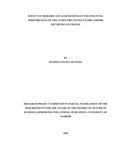| dc.contributor.author | Muinde, Lennox M | |
| dc.date.accessioned | 2019-01-30T07:35:47Z | |
| dc.date.available | 2019-01-30T07:35:47Z | |
| dc.date.issued | 2018 | |
| dc.identifier.uri | http://hdl.handle.net/11295/105967 | |
| dc.description.abstract | Companies that are doing well financially look for ways of improving their financial performance. These firms may target increasing their operations to other more or equally profitable industries or sectors of the economy. The most logical and appropriate way of making entry into a new sector, is by acquiring or merging with a company that already exists in the sector. This saves time and resources required to set up a new venture with no prior experience. M&A are therefore seen from the point of view of improving the financial performance of a smaller company. This is because it increases the asset base of the company increasing free cash flow that would be required in making investments in projects with positive NPV. This study therefore undertook to look at the effects of M&A’s on financial performance of companies listed at the NSE. The study used a descriptive research design and secondary data on financial performance measured by profitability ratio, liquidity ratio, capital structure ratio and free cash flow ratio was collected from audited financial statements of 15 companies that had all necessary data for a period of 3 years before they merged and 3 years after the companies merged. Data collected was analyzed by the use of independent test of sample means that looked at the differences between the means of these variables for the companies before merger and after merger. Diagnostic tests of normality and Levene’s test of equality of variances was undertaken. The findings were that the mean profitability of the companies after merger was greater than the mean profitability before merger. Similarly, the mean of capital structure and free cash flow was also greater after merger than before merger. However, the debt/equity ratio had mean before merger being greater than mean after merger. However, the t statistical test for equal sample means had a p value greater than alpha value for all the variables which meant that the study failed to reject the null hypothesis. It therefore implied that the financial performance of companies listed at NSE had equal means before and after M&A. There was therefore no significant effect of M&A on financial performance for the companies listed at NSE. This means that the study failed to reject the null hypothesis. It is therefore concluded that the difference in means of financial performance of companies listed at NSE before merger and after merger are not statistically significant. The study concludes that despite slight increases on financial performance for the companies after merger and acquisitions such increases are not statistically significant. This means that companies do not improve their financial performance by engaging in M&A. More synergy and approach is needed to enhance financial performance of these firms listed at NSE. The study recommends to the policy makers and regulatory authority to make provisions that would require companies engaging in either mergers or acquisitions to ensure that they set performance limits that would enhance financial performance of these companies after merger and acquisitions. | en_US |
| dc.language.iso | en | en_US |
| dc.publisher | University of Nairobi | en_US |
| dc.rights | Attribution-NonCommercial-NoDerivs 3.0 United States | * |
| dc.rights.uri | http://creativecommons.org/licenses/by-nc-nd/3.0/us/ | * |
| dc.subject | Effect Of Mergers And Acquisitions | en_US |
| dc.title | Effect Of Mergers And Acquisitions On The Financial Performance Of The Companies Listed At The Nairobi Securities Exchange | en_US |
| dc.type | Thesis | en_US |



